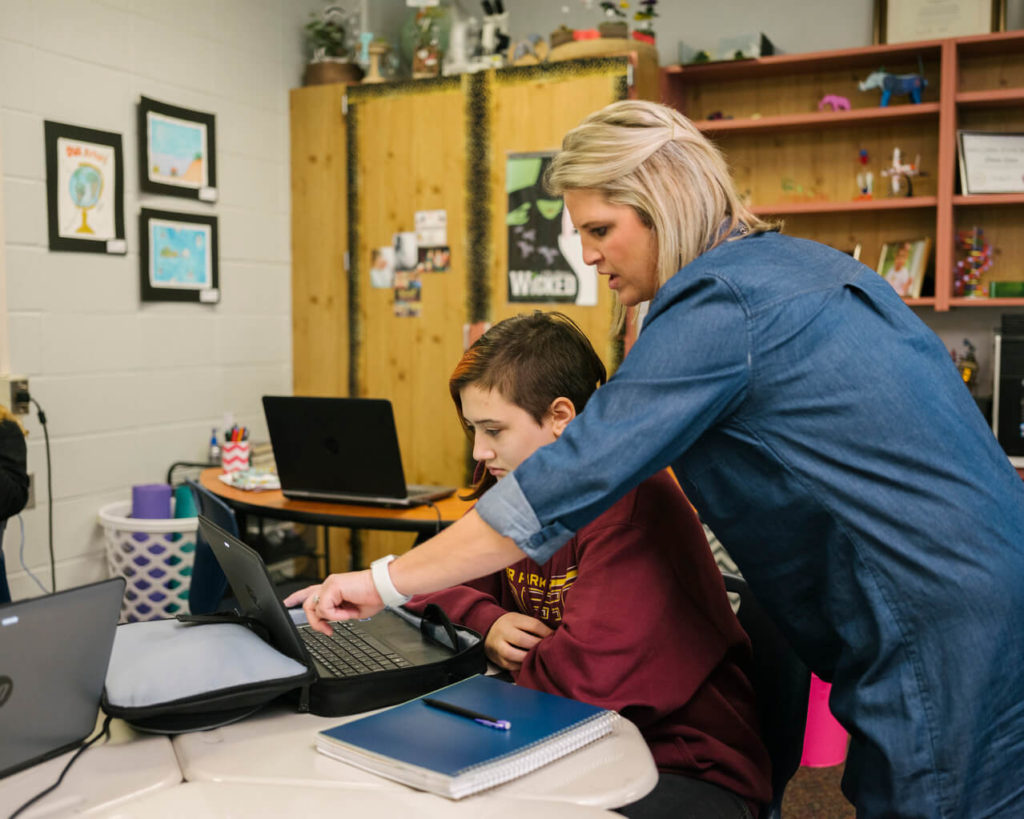As COVID-19 continues to spread across New Jersey, “long term school closures are inevitable,” said Governor Phil Murphy on Friday. All across the country school districts are scrambling to replace traditional educational models of education—the teacher standing before students imparting knowledge—with, well, something else. New Jersey Commissioner of Education Lamont Repollet said, in reference to this transition, “We are pretty much creating a new educational system.”
But at New Egypt High School, which I visited before the pandemic became front-page news, this transition will be less formidable because the staff has already created a new educational system that eliminates the “sage on stage” model. Instead, the school uses a personalized learning system supported by a robust digital platform. School leaders, teachers and parents might want to listen up to what happens when (admittedly by choice, not duress) a district puts students in charge of their own learning.
New Egypt High School teacher Sean Feddema (“Fedds” to his students) captured this when he told me, “There’s a breakthrough moment when they say, ‘I can do this myself.’”
How are they doing it? Using a digital platform called Summit Learning, which is transforming the culture of what was once a traditional district in a rural part of New Jersey.
Here, instructors rarely stand in front of the classroom and lecture to a silent throng as if each child learns in the same way. Instead, they sit side-by-side with students, serving as advisors and mentors, honing in on obstacles that interfere with academic progress, building on habits of success and urging students to be responsible for their own learning. As a result, New Egypt High School is making inroads towards equity through personalized instruction.
I’m a non-digital native so I didn’t understand how giving kids laptops and using a specific digital platform would meet the needs of individual students better than a traditional classroom structure. Aren’t computers the opposite of personalization?
So I took a road trip to New Egypt (after an invitation from New Egypt High School Principal Richard DeMarco) to see for myself. With my guides—world history teacher Sean Feddema and chemistry teacher Kaitlynn Panacek—I saw how the platform, developed by the Chan Zuckerberg Initiative (CZI provides some funding to brightbeam; brightbeam supports this blog), allows teachers to efficiently differentiate among students’ needs and provides a bridge towards project-based learning that, in fact, moves kids away from screens and into the real world.
HOW SUMMIT LEARNING WORKS
The heart of the program is the Advisory Group, held during a daily 40-minute period that cultivates the mentoring relationship between student and teacher. Freshmen are assigned to a teacher, in groups of about 15, who remains their advisor throughout high school. Feddema’s 15 advisees, now juniors, call themselves “The 203” because that’s the room number. Panacek described the daily meeting as “a study hall on steroids.”
When we entered room 203, a boy ran up to Fedema and announced, “I’m going to see my math teacher,” and promptly headed out the door, unsupervised. In this model, students themselves elect to get one-on-one help during the period. A girl sat in the corner eating her lunch and studying intensely for her upcoming AP math test. Three students sat together collaborating on a project.
Feddema visits with each one, checking their Summit platform for any new information about quizzes and class projects as well as progress on student-selected goals, which they regularly update on “Student-Directed Learning Days.” If he detects a problem—say, a student is struggling with an English paper—he’ll put together a chat with the student, teacher and himself, and they’ll work as a group to figure out next steps. While he checks on each student’s progress daily, he arranges his schedule so that each student has an in-depth session with him every other week.
As Principal DeMarco explained, “Every advisor can see what the students are doing in their classes. Every kid in the building has one or two teachers who he knows has his back. It’s built into our structure.”
I sat with a student whom I’ll call Jack. He opened up his laptop and showed me his platform, which had numerous tabs for short-term and long-term goals, homework assignments, test schedules, calendars. “As a freshman, I was so disorganized,” Jack recalled. “But with Fedds’ help I started setting weekly goals and now I know what I have to do every day. Like, I know I have track practice on Tuesday, but I also have a big English assignment, so here”—he pointed to the screen—“I’ve left a time slot so I can get my writing done. Really, it all comes down to time management.”
I noted Jack’s enthusiasm and he responded, “Oh, my teachers are so much more hands-on then they were before we had Summit. I really trust Fedds to help me stay on track.”
SHIFTING FROM ADULT-CENTERED TO CHILD-CENTERED EDUCATION
Diane Tavenner, CEO of Summit Public Schools of California and Washington (and winner of the XQ Super School Challenge), explained the strategy behind the program at an EdSource Symposium.
Imagine what is possible if we discard restraints and put students in the center. Our kids want to solve problems, and adults want them to, too.
When we change a school from an adult-centered system to a child-centered system, she says, “We put students in the driver’s seat,” and give them the freedom to do “authentic problem-solving.” This, says Tavenner, should be the “main course of learning”: Equipping kids “to think about the future and set personal goals.” But for that to happen, “roles and responsibilities have to change,” and that’s hardest for adults.
Those of us who have gone into education, we’re all about managing classrooms and delivering instruction, which is all very adult-driven. But the roles of adults have to change. We must become mentors and coaches and guides and facilitators of learning and this is made possible by tools and technology, by not allowing anyone to fall through the cracks.
Tavenner continues, “Rich families of means have individualized attention. They push kids and deeply customize content. What’s new is packaging this customization in a form so that any school can do it.”
And from what I saw, New Egypt High School is doing it.
Mr. Feddema noted after the Advisory Group period,
I didn’t learn about time management, about accountability, about managing my work independently, until I was in college. These kids will go there knowing how to advocate for themselves and learn independently. Here, we have a safety net to catch them if they fall. When they leave they won’t even need that.
But what happens, I asked, when a student isn’t ready for that responsibility? He recalled a student who was struggling with math. “We got her not to think of the work as this big scary thing, and she started taking responsibility for her own progress.”
What about students with disabilities? “Oh, we use the same process but adapt the content and goals to align with their IEP’s (Individualized Education Plans). Some of those students are our biggest success stories.”
But, I quizzed them, “Isn’t this whole thing more work for teachers?” They acknowledged that, indeed, it can be, especially before students are accustomed to the platform and before teachers have reached the top of their own learning curve.
The consensus seems to be that the extra effort pays off.
Panacek, the chemistry teacher, has freshmen now, students relatively new to the platform. How does this work with a subject like chemistry?
Although I do some direct instruction, I’m working more than ever one-on-one with each student.
Right now her class is studying the Flint water crisis. The Summit platform suggests a writing task as an end-of-unit project, but the teacher can customize to suit the students. In this case, Panacek thinks they’ll be more motivated by doing something collaborative and creative, so she’ll substitute a video-making project.
Everyone thinks that the kids will sit in front of screens all day. But that’s not true. They want to do hands-on work, and the beauty of Summit is that we can fulfill that desire while guiding them to become their own educational advocates.
Certainly, New Egypt High School will have to make its own changes as schools close for some indefinite period of time. But I’m guessing the consternation expressed by local school officials—“this is something that we never had to do before,” said the president of a county education association; “it’s unprecedented,” said a district superintendent—is an easier lift in a school where teachers are able to use technology to customize learning and where students like Jack say confidently, “I know what I have to do every day.”





2 Comments